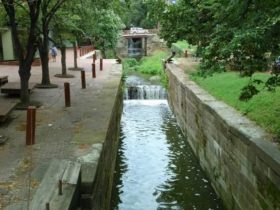C&O Canal National Historical Park
Established as a unit of the US National Park System in 1971, the 184.5-mile Chesapeake and Ohio Canal National Historical Canal is one of the nation’s great engineering feats of the early Republic. Begun in 1828 and stretching between the Nation’s Capital and Cumberland, MD, the Park survives in many places untouched from its earliest days, providing unparalleled opportunities for hiking, cycling and appreciating nature. The Eastern Canal terminus lies in a one-mile segment of DC’s historic Georgetown neighborhood, characterized by warehouses, industrial buildings and modest residences – many of which survive today.
In recent years, the commercial vitality of Georgetown near the Canal has diminished as other business and entertainment developments throughout the District have superseded Georgetown as a local destination. In an effort to reverse this trend, the Georgetown Business Improvement District partnered with the National Park Service to develop a plan to restore and “reimagine” the one-mile segment into a “must see” destination. Hiring James Corner Field Operations, the goal seeks to mirror the firm’s success in designing the New York City High Line.
While proposed elements in the plan to restore, make more accessible, and better interpret the Canal throughout the Georgetown segment are laudable, the Committee of 100 opposes certain elements to “reimagine” the Canal that are not appropriate and advocates a more restrained restoration in keeping with the original purpose and recreational use of the Park along this segment. Specific objections are to the addition of extensive tree groves, playgrounds, “period” street furniture and invasive ornamental lighting, all appropriate for the New York High Line but not to a nationally-significant, historic unit of the National Park System. The Committee will continue to monitor and comment on this project as it moves forward.
Documents
 C100 Position Paper - Proposed Revitalization Of The C&O Canal
C100 Position Paper - Proposed Revitalization Of The C&O Canal- September 17, 2019, Stephen A. Hansen
The Committee of 100 shares the concern with others that the C&O Canal is in need of attention. Enhancing access and the ways the canal is experienced, interpreted, enjoyed and available for this and future generations is obviously important for its continued survival. But the proposed enhancements cannot come at the expense of preserving what is left of the original Canal or disguising or so overwhelming it to the point that visitors will not get a sense of what it was originally. A better balance is required. These are the basic tenants of the National Park Service itself in caring for all the historic and natural treasures in its care. The C&O Canal must not be an exception. Future generations are counting on us.  2016-12 NPS CandO Flood Plan Annex Lower Reach
2016-12 NPS CandO Flood Plan Annex Lower Reach- December 2016, National Park Service
The Potomac River has a long history of flooding.
The largest of which on record occurred in 1936 when the river crested at 28 feet and
produced total flows estimated to be about 484,000 cubic feet per second. Potomac
River floods typically have a total duration ranging from 100 to 180 hours (4 to 7 days).  C100 Comments On The National Park Service Environmental Assessment Of The C&O Canal National Historical Park Georgetown Plan
C100 Comments On The National Park Service Environmental Assessment Of The C&O Canal National Historical Park Georgetown Plan- January 5, 2018, Stephen A. Hansen
The concept plan offers excellent ideas, including refilling the canal, restarting canal boat rides, adding a new visitor center, improved signage, and grading the towpath for safety. The canal has endured repeated and severe floods, scouring the canal and damaging its structure. Therefore, for the concept plan to succeed, every alternative selected must be sustainable, able to withstand flooding. For example, flood-vulnerable alternatives such as boardwalks, elevators, new flower beds, and alternatives B and C for the towpath should be re-evaluated.  C100 Section 106 Review Comments On The October 2017 C&O Canal Concept Plan
C100 Section 106 Review Comments On The October 2017 C&O Canal Concept Plan- January 5, 2018, Stephen A. Hansen
We applaud the National Park Service’s, Georgetown Heritage’s, and The Georgetown Business Improvement’s interest in rehabilitating and increasing public enjoyment and access to the one-mile C&O Canal section in Georgetown. However, these laudable goals must not be achieved at the expense of the Canal’s historic character and significant constituent elements. Such appears to be the likely outcome in many of the Plan design alternatives and, if built, will result in significant adverse impacts to the Canal as defined under Section 106 (36 CFR Part 800 Protection of Historic Properties), National Historic Preservation Act (P.L. 89-665; 54 U.S.C. 300101 et seq).


